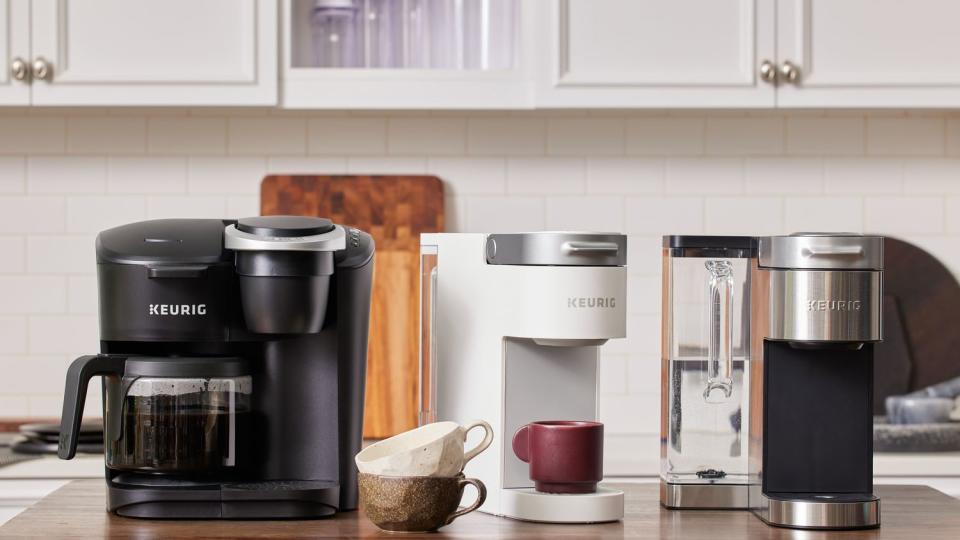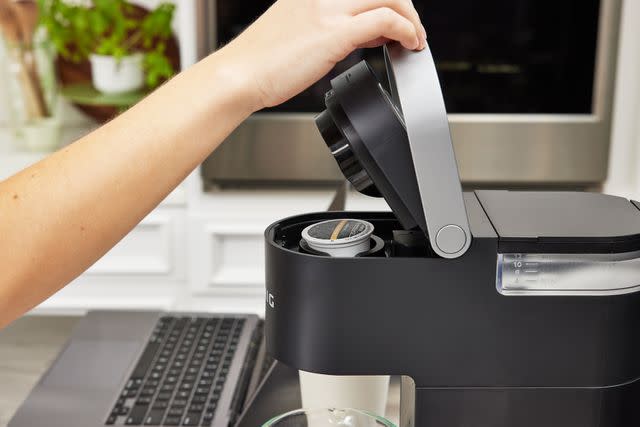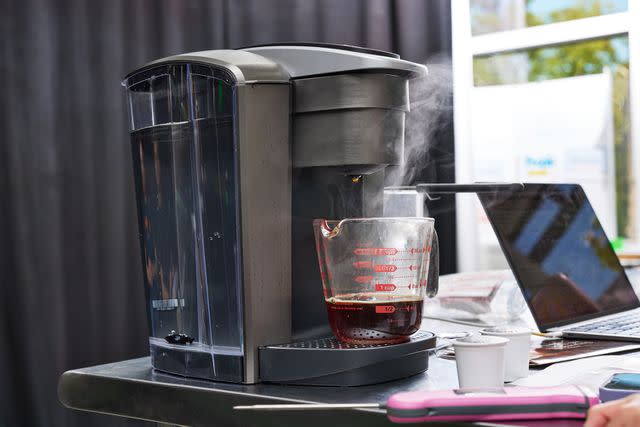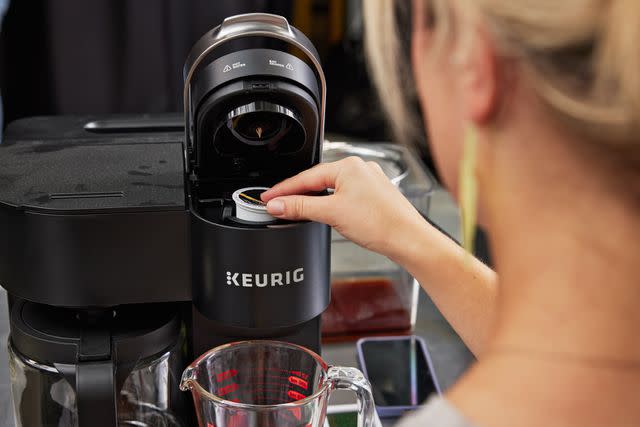How Do Keurig Coffee Makers Work, Anyways?
Dotdash Meredith and Yahoo Inc. may earn commission or revenue on some items through the links below.
And why we wouldn't recommend buying one.

Serious Eats / Will Dickey
Keurig coffee makers are convenient but fall short on brewing-great tasting coffee. With their technical limitations, environmental concerns, and pricey K-cups, we think they’re probably worth passing on if you're prioritizing coffee quality. However, we can also see why they may be right for some users.
Originally launched in 1998 for offices, the Keurig machine and its accompanying K-cups introduced the world to the pre-packaged capsule that can brew a single cup of coffee at a time. There’s something to be said for convenience, and Keurig machines gained three million new users in 2020 alone.
But a Keurig, no matter how consistent, can’t match high-quality coffee that’s ground just before brewing. There are several limitations to these brewers. Here’s why we don’t recommend them over automatic drip machines.
How Do Keurig Machines Work?
Keurig K-Mini Coffee Maker

Keurig K-Elite Single Serve Coffee Maker

While a drip coffee maker uses a flash-heating chamber and gravity to brew, Keurig machines employ a water and air pump to pressurize their brew process. This added pressure is key: it allows Keurigs to force water through each K-cup, and speed up the brewing process from three to four minutes to mere seconds.
When you set a K-cup into the machine, the top foil is punctured by five needles to allow the pressurized water in, while the bottom of the plastic cup is punctured a single time to allow the brewed coffee to drain. Each K-cup functions not only as packaging for the coffee inside, but also as a brewing chamber and coffee filter.
It’s a fascinating piece of technology, but there are some flaws to its design.
For Starters, There’s Not Enough Coffee

Serious Eats / Isaac Nunn
Most K-cups are filled with eight to 12 grams of pre-ground coffee, and since the Specialty Coffee Association recommends 55 to 60 grams of coffee per liter of water (around 14 grams for an 8-ounce cup), they should really only be brewed with four to six ounces of water. Most Keurig brewers default to eight ounces, and don’t even offer a 4-ounce option. Too much water and not enough coffee leads to thin, weak brews, but running extra water through the same amount of coffee also overextracts the grounds and pulls more bitter flavors into the cup.
The Grind Is Too Fine
To make up for the lower coffee dose, coffee is ground very finely before it’s packed into a K-cup. While a finer ground coffee will help boost brew strength at a low coffee to water ratio, the extra extraction will also start to pull more of the bitter, dry flavors out of the grounds. Too much water and too fine of a grind means that, no matter what, it’s likely that a Keurig is going to extract more bitterness than a standard drip machine.
It Brews Too Fast at Too Low of a Temperature

Serious Eats / Isaac Nunn
Every Keurig machine is calibrated to brew at 192ºF, which is lower than the ideal 195-205ºF brew temperature range. Brew temperatures that are too low have a hard time extracting the denser, caramelized sugars in ground coffee, which means Keurig machines struggle to get sweetness into the cup. At the same time, it takes three to four minutes of extraction time to zero in on those sweeter flavors, and the Keurig’s condensed, one-to-two-minute brew time, even with its pressurized boost, is just too short.
There’s No Way Around It: That Coffee Is Old
Roasted coffee gives off carbon dioxide gas for about two weeks after it’s been roasted, which helps keep it from oxidizing and going stale. That means, in order to seal coffee in airtight capsules, coffee for a K-cup must be sitting for at least that long before it’s packaged, or the capsules will explode. Coffee also loses most of its aromatics within minutes of being ground, which means that every K-cup is packed with coffee that’s likely already oxidized and gone stale.
It’s Bad for the Environment—and Expensive

Serious Eats / Isaac Nunn
Since 2020, Keurig has switched all of its K-Cups to being recyclable. But even with the switch to #5 rated polypropylene, plastics just are not being recycled. The overall environmental impact of single-serve plastic capsules is pretty staggering, with billions of capsules ending up in landfills or being washed out into the ocean every year.
They’re also extremely expensive. A pack of 60 Starbucks K-cups is priced out at $.95 per serving, while buying a bag of their coffee works out to be around $.34 per serving: almost a third of the cost. That means K-cups are around three times more expensive than buying whole bean or ground coffee. And while you can buy reusable K-cups and fill them with your own coffee, the issues with brew time and temperature still remain.
Are There Any Pros?
The case against K-cups is pretty strong: they don’t taste great, they’re bad for the environment, and they’re three times more expensive than buying whole bean coffee. However, Keurigs are still very convenient. Because Keurig machines operate on a closed system for single-serve brewing, they’re easy for people with limited mobility to use. And for those who are infrequent coffee drinkers, a single-serve machine like a Keurig might make more financial sense than having a bag of coffee in the cabinet go stale. But there are alternatives, too.
So, What Should You Consider Instead?
Spinn Pro Coffee Maker

If you’re in the market for a single-serve brewer, we were impressed with the Spinn Pro Coffee Maker. Though it’s a much pricier piece of equipment, the Spinn offers fully-automated single-serve brewing from whole bean coffee. If you drink at least two cups a day, however, you could save around $400 in coffee cost alone, quickly closing the price gap between the Spinn and a Keurig.
Steeped Coffee Single-Serve Packs

You could also forgo the machine altogether. Steeped Coffee is a single-serve filter bag, packing ground coffee similarly to how a tea bag would be. And Swift Coffee offers high-end instant coffee by freeze drying good quality coffee that’s been brewed to exact specifications. Both Steeped Coffee and Swift Coffee work with a variety of specialty coffee roasters, too, so you might even be able to find a single-serve option from your favorite brand.
FAQs
Is it worth it to get a Keurig?
While Keurig machines offer great convenience, they don’t brew very tasty coffee. They also have a high environmental impact due to excessive plastic waste, and the K-cups themselves are much more expensive than buying a bag of coffee.
Can you put regular coffee in a Keurig?
There are reusable coffee pods offered for Keurig machines, made by Keurig itself and third party manufacturers. These pods allow you to add your own ground coffee, cutting down on both the environmental impact and cost per serving.
Why is drip coffee better than a Keurig?
Automatic drip coffee makers allow you to control the amount of coffee to water and the grind size, and a high-end coffee maker can deliver the correct water temperature and brew time. Having the freedom to fine tune each of these variables allows you to make much better coffee than you could with pre-packed, pre-ground K-cups.
Why does coffee from a Keurig taste burnt?
One of the ways that a burnt or bitter flavor might show up in a Keurig is a build up of old coffee oils. Because Keurig machines use pressurized pumps to force water through the coffee filter, some of that brewed coffee tends to travel back through some of the tubing in the system where coffee oils can go rancid over time. Because it's harder to clean the insides of a Keurig than a regular automatic drip machine, this tends to happen more often than with standard brewers. Be sure you follow the manufacturers instructions for deep cleaning to avoid this.
Read More:We Tested Coffee Makers and Landed On 3 Favorite Brewers

